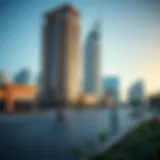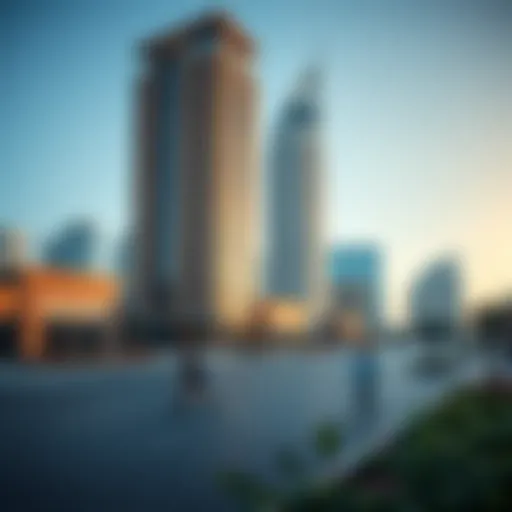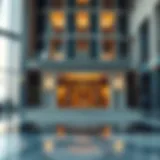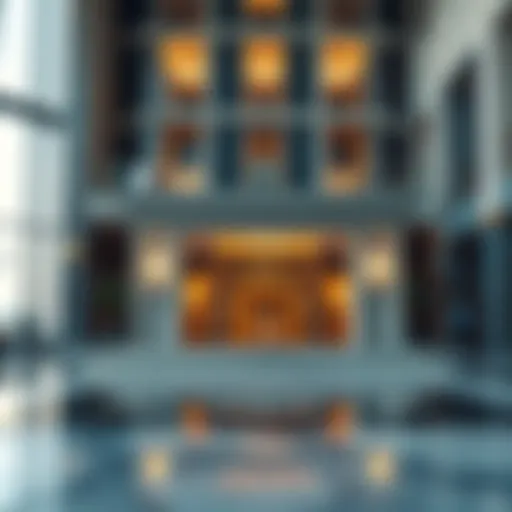DIFC Building: Architectural Impact and Market Trends
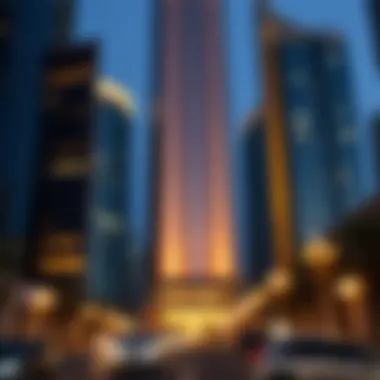

Intro
The architectural realm in Dubai is largely defined by its ambitious structures, but few hold the significance of the DIFC Building. Nestled in the heart of a bustling metropolis, this striking edifice is more than just an office space; it symbolizes the aspirations and potential of a city vying for a prominent spot in global finance. In recent years, the Dubai International Financial Centre has not only gained recognition for its unique design and aesthetic appeal but also for its pivotal impact on the local real estate landscape.
As we peel back the layers of the DIFC, it's essential to understand the factors contributing to its status. The DIFC Building stands tall, embodying modern architecture forged from both innovation and necessity. The influence it wields extends beyond mere bricks and mortar, shaping market trends, investment opportunities, and the broader dynamics of real estate in the region.
This article aims to provide a comprehensive guide, diving into architectural significance alongside market implications. By focusing on the intricacies of the DIFC, we will shed light on key trends affecting investors and homebuyers alike. Understanding the essence of this building and its surroundings is crucial for those looking to navigate the ever-changing landscape of Dubai's real estate market.
Intro to the DIFC Building
The Dubai International Financial Centre (DIFC) Building is more than just a structure; it’s a cornerstone of Dubai’s ambition to establish itself as a global financial hub. This complex stands tall amidst the iconic skyline of Dubai, serving as a beacon for business and modern architecture. The importance of the DIFC Building in this article revolves around several critical aspects: its architectural brilliance, its role in the local and global financial market, and what it signifies for investors, homebuyers, and developers alike.
The design of the DIFC Building reflects not just aesthetic values but also functional ones, symbolizing stability and resilience in a rapidly changing economic landscape. Anchored by a framework of cutting-edge technology and sustainability, it draws the interest of stakeholders from all over the world. Understanding this building’s significance provides valuable insight into the broader implications for potential investments and business opportunities.
Key Elements
- Cultural Icon: The DIFC stands as a cultural landmark that represents Dubai’s growth in the financial sector.
- Economic Pillar: Hosting numerous companies, the DIFC has a direct impact on Dubai’s economy and provides a foundation for high value jobs and investments.
- Sustainability Commitment: Features such as green architecture show Dubai's commitment to environmental stewardship, making it an attractive destination for future developments.
Benefits of Understanding the DIFC
- Insight into Investments: Knowing about the DIFC's role helps stakeholders make informed decisions regarding investments in Dubai’s flourishing market.
- Awareness of Market Trends: As the DIFC adapts, so too does the surrounding real estate landscape. Understanding its growth can inform buyers about emerging trends and opportunities.
- Navigating Regulations: Familiarity with the DIFC's significance aids in navigating the legal and financial frameworks that govern property ownership and development.
"The DIFC is not just about finance; it’s about the cultural and infrastructural evolution of a city that continues to inspire."
For more detailed insights related to this topic, consider visiting Dubai Government's official portal or check the comprehensive overview on the Wikipedia page for DIFC.
Historical Context
Understanding the historical context of the Dubai International Financial Centre (DIFC) Building is crucial for grasping its significance within both the architectural and economic landscape of Dubai. The DIFC has become a textbook example of how urban development can intertwine with global financial aspirations. This context allows us to appreciate the broader implications the structure has had on local society, culture, and the region’s standing in the international market.
Foundation of DIFC
Established in 2004, the DIFC was designed to serve as a financial hub that would attract international investment into the UAE and the broader Middle Eastern region. The motivation behind creating the DIFC stemmed from Dubai’s ambition to diversify its economy away from oil dependency, fostering a shift towards knowledge-based industries and financial services. The foundation of the DIFC was marked by a legislative framework that provided a robust legal environment, which included its own courts and arbitration services designed to cater specifically to the needs of global business.
The DIFC aimed to create an oasis for finance, complete with modern infrastructure, world-class amenities, and a favorable regulatory environment. This foundation laid down not just the physical structure, but also a conceptual framework through which businesses could operate efficiently. The financial framework was complemented by the strategic geographic location of Dubai, making it an ideal link between markets in Europe, Asia, and Africa.
Evolution over the Years
As times change, so do the needs of the industries that the DIFC attracts. Over the years, the DIFC has undergone significant evolution, adapting to shifts in the global economy and advances in technology. Initially, activity within the DIFC was heavily centered on banking and financial services. The emergence of fintech in the last decade has expanded this dynamic, leading to the establishment of numerous startups and innovation centers within the center.
Notably, the DIFC has evolved into a vibrant community fostering creativity and collaboration, where diverse professionals mingle in a cosmopolitan environment. The evolution continued with infrastructural development as new skyscrapers and office spaces sprang up, reflecting both ambition and aesthetic appeal.
"The DIFC symbolizes Dubai's progressive commitment to establishing itself as a financial capital on the world stage."
This evolution isn't merely about physical expansion; it's also about the cultural integration within the community. The DIFC now hosts a wealth of restaurants, art galleries, and cultural events, enriching the lifestyle for residents and workers alike. This transformation showcases how the center has not only contributed towards economic gains but also helped cultivate a unique identity for Dubai, all stemming from that significant foundation laid in the early 2000s.
Architectural Features
The architectural features of the DIFC Building encapsulate an era of innovation, elegance, and functionality. The way a structure manifests its surroundings can set a tone for its purpose and influence the experience of its users. This section will explore the various aspects of the DIFC Building that illustrate its architectural significance and market impact, highlighting unique elements that contribute to its stature.
Design Philosophy
The design philosophy behind the DIFC Building is quite striking. It represents not just a space for commerce but embodies the spirit of Dubai itself—an ambitious blend of tradition and modernity. The sleek lines and glass façade invite in natural light, while the angular structures create a dramatic silhouette against the skyline. This design doesn’t merely function on aesthetics but also addresses practical concerns such as maximizing workspace efficiency and minimization of energy consumption.
The overall styling is inspired by a fusion of Middle Eastern and contemporary influences, marrying local culture with global standards. It aims to foster creativity and communication among its inhabitants. For investors and agents, this blend of functionality and aesthetic appeal can significantly enhance property values and attraction to businesses.
Materials and Techniques


The choice of materials in the construction of the DIFC Building plays a vital role in its overall architecture. Glass and steel dominate, creating a powerful statement about transparency and resilience. High-performance glass not only allows for stunning visual displays but also offers thermal efficiency. This is crucial in the harsh climate of Dubai, ensuring that interior spaces remain comfortable despite soaring outside temperatures.
Innovative construction techniques were employed to ensure the structural integrity required for such an ambitious project. The use of modular construction methods has allowed for quicker build times and enhanced precision. These techniques also lead to reduced waste, contributing positively to sustainability efforts.
Sustainability Initiatives
In the context of rising environmental concerns, the DIFC Building is a forward-thinking structure. Sustainability initiatives are integrated throughout the design, starting from energy-efficient systems for heating and cooling to water conservation measures. The building has been designed to minimize its carbon footprint and promote energy efficiency, aligning with Dubai's broader ecological goals.
Moreover, the incorporation of green roofs and vertical gardens enhances the aesthetic while also improving air quality. This dual focus on sustainability and market readiness makes the DIFC Building a prime candidate for discerning investors aiming to capitalize on green investments.
"In an era where economic viability will be heavily influenced by sustainability practices, being ahead of the curve can give investors a competitive edge."
The architectural features of the DIFC Building are more than mere aesthetics or technicalities; they embody a philosophy that considers both form and function, crucial for investors and potential buyers aiming for long-term growth and stability in a dynamic market.
Economic Significance
The economic importance of the DIFC Building extends beyond its striking silhouette against Dubai’s skyline. Rooted in its strategic location, the DIFC serves as a financial bridge between East and West, attracting not just local but also international investments. Its establishment fosters a thriving ecosystem that supports innovation, legal frameworks, and an influx of top-tier talent, proving instrumental in bolstering Dubai's economic standing on the global stage.
Role in Dubai's Economy
The DIFC acts as a linchpin of Dubai's economy, primarily due to its concentration of financial services. With thousands of licensed firms operating within its precincts, from major banks to asset management companies, the DIFC provides a crucial platform for businesses operating in the Middle East, Africa, and South Asia. The economic activities driven by these firms contribute significantly to Dubai's GDP.
"The DIFC is not just a physical space; it represents an intersection where commerce, culture, and community converge, influencing economic growth on multiple levels."
The integration of regulatory frameworks within the DIFC has also fostered a transparent and investor-friendly environment, laying down guidelines that align with international standards. This has cemented Dubai’s image as a stable location for business endeavors, making it an attractive option for investors searching for robust returns.
Attraction of Global Companies
The allure of the DIFC extends to global corporations scouting for opportunities in the Emirates. The infrastructure, coupled with a well-developed support system for businesses, provides a compelling case for firms to set up shop here. Companies like HSBC, Goldman Sachs, and Deutsche Bank have already established their regional headquarters in the DIFC, citing proximity to critical markets as a central factor in their decision-making process.
Moreover, the DIFC’s commitment to innovation has led to the establishment of specialized zones encouraging fintech and other tech companies to thrive. The combination of a supportive ecosystem and a diverse talent pool creates an environment ripe for collaboration and growth.
With continued emphasis on enhancing the business landscape, Dubai’s DIFC will remain a cornerstone for global enterprises aiming to tap into the Middle Eastern markets. Investors and business owners can derive extensive benefits from the opportunities it presents, particularly as it continues to evolve and adapt to market shifts.
Impact on Real Estate Market
The significance of the Dubai International Financial Centre (DIFC) extends beyond its remarkable architecture. It plays a crucial role in shaping the dynamics of the real estate market in Dubai. This impact can be noticed through various lenses, from commercial property trends to the residential developments that are springing up around it. Analyzing these factors yields valuable insights for investors, homebuyers, and developers looking to navigate this ever-evolving landscape.
Commercial Property Trends
The DIFC is nothing short of a magnet for commercial real estate activity. It attracts a myriad of international corporations and business professionals, engendering a thriving business ecosystem. As demand for office space swells, so do the trends within the commercial property market.
- High-Quality Office Spaces: The centre has spurred a drive for high-quality office spaces. Investors are increasingly seeking out buildings with state-of-the-art facilities, sustainability features, and prime locations. The rise of flexible workspaces and co-working environments also reflects this shift, as companies adapt to new work environments post-pandemic.
- Rental Rates: With demand also comes the natural increase in rental rates. Properties situated within the DIFC are often perceived as prestigious addresses. This perception can inflate prices, making it crucial for investors to factor in both current trends and future projections when evaluating potential investments.
- Long-Term Leases: Companies opting for long-term leases are making a statement about their commitment to the region. This trend not only adds a layer of stability to the investment landscape but also indicates a strong belief in the future growth of the area.
Notably, some companies view a presence in the DIFC as a badge of honour, believing that it can enhance their company's credibility in the eyes of clients and partners. Such sentiments foster a competitive environment for investors, ensuring that properties within this financial hub maintain their allure and value.
"The DIFC is not just a location; it's a statement. It conveys ambition and connectivity on a global scale."
Residential Developments Nearby
The ripple effect of the DIFC's commercial thriving also influences the residential market adjacent to it. Developers are not blind to the increasing demand for housing options close to this business hub. Residents enjoy the convenience and lifestyle that comes with living near significant commercial activity.
- Luxury Apartments: The proximity of the DIFC to desirable residential neighborhoods has led to the emergence of luxurious apartment complexes. These developments frequently feature amenities like fitness centers, swimming pools, and scenic views. They aim to cater to young professionals and expatriates who look for upscale living experiences combined with ease of access to their workplaces.
- Mixed-Use Developments: The trend toward mixed-use developments is blooming. These projects often combine residential, commercial, and retail spaces, offering residents the conveniences of shopping, dining, and work without needing to travel far.
- Community Focus: A notable trend is the emphasis on creating a sense of community through thoughtfully designed public spaces, parks, and recreational areas. Such initiatives foster a vibrant lifestyle for those living in proximity to the DIFC, encouraging interaction and engagement among residents.
Understanding these trends can aid investors and analysts in making informed decisions. Those eyeing residential properties should consider not only immediate returns but the long-term potential driven by the DIFC's continued expansion and influence on the urban fabric of Dubai.
Investment Opportunities
The Dubai International Financial Centre (DIFC) is not just a slice of architectural beauty; it’s a bridge connecting investors to vast opportunities in one of the world’s most dynamic markets. Recognizing the significance of these investment opportunities in the DIFC helps paint a clearer picture for homebuyers and investors who are looking for stable and potentially profitable endeavors.


Understanding the Market Dynamics
DIFC's market dynamics are intertwined with various local and global trends. The center attracts a multitude of international firms, which can drive demand for both commercial and residential properties. As companies set up their operations in this financial hub, the surrounding areas typically experience a surge in real estate interest.
- Supply and Demand: The rising number of businesses seeking space results in increased demand for office spaces. This creates pressure on pricing, often leading to appreciation in property values over time.
- Economic Factors: The local economic landscape is robust, supported by a government keen on attracting foreign investments. Tax incentives and an investor-friendly regulatory environment further entice businesses.
- Global Trends: Investors often keep an eye on global economic conditions and trends in finance; shifts in these areas can instantaneously impact local market sentiment.
"Understanding the dynamics of DIFC not only offers insights into potential returns but also reflects a broader view on what drives the regional economy."
Prospective Developments
Looking ahead, several prospective developments are on the horizon within and around DIFC. These initiatives promise to buttress the already booming real estate market and can yield high returns for prudent investors.
- Expansion of Commercial Spaces: As demand continues to rise, plans for new office buildings and expansion of existing structures are being finalized. This includes speculative projects targeting tech firms and financial service providers.
- Mixed-Use Developments: There is a growing trend towards mixed-use developments, which incorporate retail, food, leisure, and living spaces. Such developments cater to the lifestyle preferences of today's professionals, enhancing appeal for investment.
- Infrastructure Investments: Ongoing improvements to transport links, such as the new metro lines and road expansions, can notably increase accessibility, drawing more businesses and revitalizing neighborhoods.
- Sustainability Initiatives: A significant push towards green buildings and sustainable practices is paving the way for future projects. Properties that prioritize sustainability can attract environmentally conscious investors.
- Community Enhancements: Plans for parks, cultural zones, and entertainment venues aim to enhance the quality of life for residents and workers in the area. This type of community-centric development can make the DIFC more attractive for potential buyers and tenants alike.
Navigating through these investment opportunities requires a keener eye for detail, and understanding the evolving landscape of DIFC is essential for those looking to make informed decisions in a competitive market.
Community and Lifestyle
In the realm of modern urban development, the concept of community and lifestyle within the DIFC area presents a compelling case study of how architectural spaces can foster interaction and connectivity. Understanding these aspects is vital, particularly for investors and homebuyers seeking to navigate the bustling markets of Dubai. As the DIFC continues to evolve, so do the opportunities for vibrant lifestyles that blend work and leisure seamlessly.
The DIFC is not merely a workspace; it's a hub that effectively intertwines professional and personal experiences. With its elegant design and strategic layout, the DIFC offers a plethora of amenities catering to various lifestyles. This community-focused development encourages networking, cultural engagement, and personal enrichment. For many, living in or around the DIFC translates into easy access to top-notch facilities and lifestyle conveniences that enhance daily life.
Amenities within the DIFC
DIFC has strategically elbowed its way to the top of Dubai’s amenities list. Its offer is akin to a buffet where everyone can find something to whet their appetite.
- Dining Options: One can find a cornucopia of dining establishments, from high-end restaurants to casual cafes. Places like Zuma and Cipriani surround the area, feeding both the body and the soul.
- Shopping Experiences: The vicinity teems with retail outlets, boutiques, and art galleries. This aesthetic avenue not only enhances the community experience but also aligns with investor interests given the potential for consumer-driven development.
- Wellness and Fitness: Health takes center stage too, with numerous gyms, yoga studios, and wellness centers readily available. This is crucial for professionals seeking balance in their fast-paced lives.
The melting pot of these amenities fosters a sense of belonging. Professionals working in the area step out of their offices and into a lively scene that promotes relaxation and social interaction.
Cultural Significance
Culturally, the DIFC is akin to a careful tapestry woven from threads of different cultures and influences. Inhabiting the nexus of global finance, this community celebrates diversity through its various cultural initiatives. Events ranging from art exhibitions to cultural festivals are regularly hosted, providing a platform for expression that transcends borders. The art installations scattered throughout the DIFC speak volumes about this ethos, enriching the urban environment.
Furthermore, spaces like the Art Gallery in DIFC foster dialogue and appreciation for contemporary creativity, drawing both locals and tourists alike. This cultural vibrance makes the area more than just about commerce; it becomes a place for experiences, learning, and collaboration.
"The DIFC stands as a testament not just to architectural brilliance but to the cultural depth that can thrive in a business environment."
For investors and homebuyers, this cultural significance represents more than just lifestyle; it is an investment in a flourishing community where culture, interaction, and growth accompany economic promise. The blend of amenities and cultural engagement not only attracts potential residents but also ensures that the community remains a dynamic and desirable location for families and professionals alike.
Legal Framework
Understanding the legal framework surrounding the Dubai International Financial Centre (DIFC) Building is essential for anyone navigating this vibrant market. It lays down the rules of engagement for investors, developers, and tenants alike, ensuring that all parties involved operate within a structured environment.
Regulatory Environment
The regulatory environment within the DIFC is unique and plays a crucial role in fostering a transparent and efficient market. Governed by an independent authority, the DIFC has its own legal system and court, which is modeled on common law principles. This independence from Dubai's local judicial system lends a sense of stability that many investors find reassuring.
Several key regulations govern operations in DIFC:
- DIFC Law No. 1 of 2004: This is the foundational law that established the DIFC as a financial free zone. It details the powers of the DIFC Authority and sets the stage for a comprehensive legal framework.
- DIFC Companies Law: This law outlines guidelines for establishing and managing companies, which is particularly important for foreign investors looking to set up operations.
- DIFC Employment Law: It regulates the employer-employee relationship within the center, laying out rights and obligations for both parties, which is key for those engaged in the local labor market.
Moreover, the DIFC's regulatory framework is designed to attract international businesses and facilitate cross-border transactions. The ease of doing business here, coupled with effective dispute resolution mechanisms, such as arbitration, significantly reduces the risks associated with commercial ventures.
Ownership Regulations
Ownership regulations in the DIFC are tailored to support both foreign and local investors. This aspect is vital, especially since it directly pertains to how individuals and corporations can acquire property and assets in the area.


- 100% Foreign Ownership: One of the most appealing features of the DIFC is the policy that allows 100% foreign ownership of businesses. This is a major draw for international firms as it eliminates the requirement for a local partner, a common practice in other parts of the UAE.
- Freehold Property Rights: Investors can also purchase freehold properties within the DIFC, a feature that is more restrictive in other emirates. This ownership model provides them with complete control and the ability to lease or resell the property as they see fit, increasing the attractiveness of the market.
- Property Registration: The DIFC has established a streamlined process for property registration which is critical for ensuring legal clarity and security in transactions. Investors can be confident that their rights are protected.
In summary, the legal framework of the DIFC is not merely a set of rules but a robust structure that fosters confidence in the market. It blends the ease of operation with necessary protections, positioning the DIFC as a global hub for finance and commerce.
Challenges and Opportunities
In the realm of urban development, the DIFC Building stands as both a beacon of progress and a case study in the complexities of navigating modern architectural and economic landscapes. This section dives deep into the challenges and opportunities brought forth by its existence, offering insights crucial for investors, homebuyers, real estate agents, analysts, and developers alike.
Market Fluctuations
The market surrounding the DIFC is anything but static. Market fluctuations can be seen as a double-edged sword. On one side, they present potential hurdles. For instance, changes in global economic conditions can lead to shifts in investment patterns. When there’s a downturn, the ripple effect can impact rental yields and commercial occupancy rates within the DIFC.
Yet, these fluctuations also serve as a call to action. Savvy investors often seek opportunities in areas where prices dip, positioning themselves to reap rewards when the market rebounds. The historical data of the DIFC shows that periods of instability can lead to unique buying opportunities, particularly for residential and commercial segments.
Furthermore, understanding market dynamics helps stakeholders leverage favorable conditions. Analysts should monitor trends in rental prices, shifts in demand, and emerging global economic indicators that affect local markets. It’s a delicate dance of timing and knowledge.
Emerging Trends
Looking ahead, some emerging trends can potentially reshape the future of the DIFC and its market. The rise of digital transformation and remote work has impacted the demand for traditional office space. More companies are considering flexible work arrangements, leading to a rethinking of office layouts and sizes. The DIFC may need to adapt to incorporate these changing needs, fostering spaces that foster collaboration rather than just cubicles.
Additionally, sustainability has emerged as a significant influence. As investors increasingly factor in environmental considerations into their decisions, developments within the DIFC might need to prioritize green building standards and energy-efficient designs. This not only aligns with global sustainability trends, but it can attract a specific demographic of businesses looking for eco-friendly footprints.
Moreover, the push for mixed-use developments is gaining traction. Stakeholders are now recognizing the value of integrating residential, commercial, and recreational spaces. Such developments not only enhance community living but also create avenues for increased foot traffic and business opportunities. The evolution of the DIFC into a more holistic space may result in a more attractive environment for both residents and businesses.
Ultimately, the future of the DIFC Building lies in its ability to adapt and respond to these challenges and opportunities. As the region continues to grow and change, so too must the strategies of those who engage with it. By understanding market fluctuations and embracing emerging trends, stakeholders can better position themselves to thrive in this vibrant environment
"Innovation is the ability to see change as an opportunity - not a threat."
As the DIFC stands at a crossroads, stakeholders must wield this insight as a lantern to navigate the complexities of the future.
Future Developments
The ongoing evolution of the Dubai International Financial Centre (DIFC) is a focal point for understanding the direction of Dubai’s urban landscape and its economic vitality. Future developments within the DIFC are not merely architectural projects; they represent a synthesis of ambition, innovation, and strategic planning aimed at reinforcing the area’s position as a global financial hub. As such, keeping a keen eye on these prospective changes yields significant benefits for investors, homebuyers, and industry analysts alike.
Predictions for the DIFC
Predictions surrounding the DIFC involve a blend of developments aimed at modernizing the existing structures while adding new edifices that capture the essence of contemporary architecture. Recent trends indicate that mixed-use developments will be a primary focus moving forward. The inclusion of both residential and commercial spaces encourages a vibrant community atmosphere and meets the demands of professionals who prefer living close to their workplace.
Key elements expected in these future developments include:
- Smart city initiatives: Incorporating tech solutions that enhance efficiency in logistics, communication, and energy usage.
- Green spaces: Enhancing the urban environment with parks and leisure areas to foster well-being and community interaction.
- Cultural installations: Efforts to integrate art and heritage into the architecture that aligns with the cosmopolitan flavor of Dubai.
The architectural landscape is poised for a dramatic shift in zoning plans, which will likely prompt an influx of businesses attracted to the innovative environment. It is predicted that within the next five to ten years, the DIFC could witness a resurgence in foreign investment due to these reinvigorated developments. As markets expand globally, maintaining competitive edge through such urban enhancements is crucial.
Potential Impact on the Community
Future developments in the DIFC are bound to have profound implications for the surrounding community. As new structures rise and existing ones are updated, changes will be felt on multiple levels:
- Economic uplift: Increased job creation during construction and subsequent operations will provide employment opportunities for locals and expatriates.
- Enhanced lifestyle: With a diverse range of residential options stemming from mixed-use projects, more individuals will have access to high-quality living environments, fostering a sense of community.
- Cultural integration: The introduction of cultural spaces not only beautifies the area but also fosters communal connections through events, exhibitions, and festivals.
"Future developments aren’t just about buildings; they’re about the lives they will touch and the community they will shape."
These trends suggest that the DIFC will solidify its role as a catalyst for economic growth and social cohesion within Dubai. As homebuyers and investors, recognizing the potential of these forthcoming changes can offer a strategic advantage to those looking to make informed decisions in a dynamic market.
The expected transformation of the DIFC stands as a testament to how thoughtful urban planning can yield dividends for investors while enhancing the quality of life for those living, working, and engaging in this vibrant district.
Closure
In reviewing the various aspects of the DIFC Building, it becomes clear that its architectural significance and market impact resonate profoundly within Dubai's urban landscape. The DIFC is not merely a collection of glass and steel. Instead, it stands as a beacon of innovation and prosperity, drawing in businesses and investors from across the globe. This iconic structure exemplifies how thoughtful design can serve not just aesthetic purposes but also fuel economic growth and community engagement.
From the historical foundation that shaped its necessity to the cutting-edge architectural features that define its presence today, the DIFC has drawn a connection between the past and future of the financial markets. Its strategic location and the regulatory framework surrounding it create a conducive environment for international companies looking to plant roots in one of the world’s most dynamic cities.
The economic significance of the DIFC extends well beyond its walls. It prioritizes collaboration and connectivity, fostering a robust market that feeds into the surrounding real estate trends. Prospective buyers and investors are consistently attracted to its promise of growth, making it an enticing prospect for anyone interested in tapping into Dubai’s thriving economy.
Furthermore, the emphasis on sustainability initiatives indicates a commitment to adapting to modern ecological needs, ensuring that the future of the DIFC aligns with global trends toward sustainable living and business practices.
